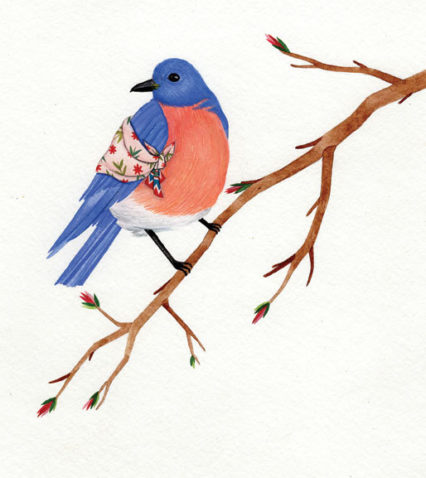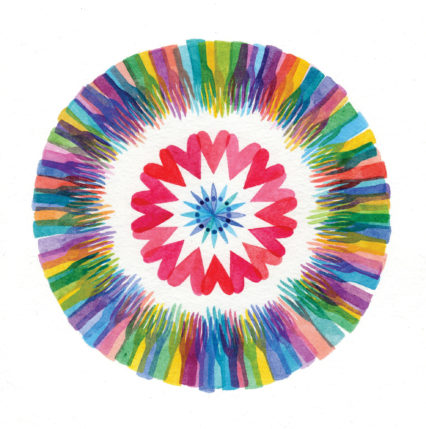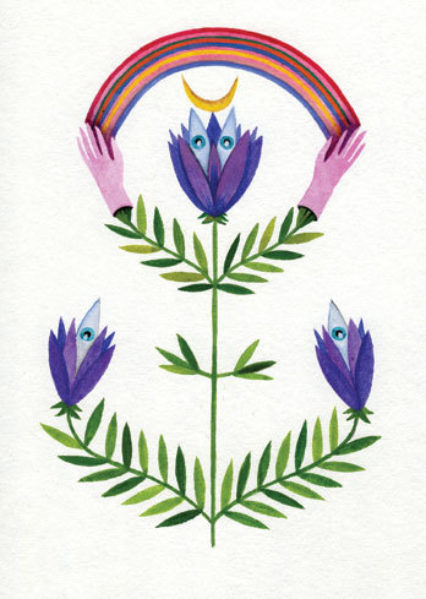The Secret of Healing Touch
As I Say, Not as I Do by Caitlin McDonagh
The case of Mr. Danska would be just a one-night stand, but it would get me thinking about how medicine has something unexplainable about it, which is its heart.
It started one night when I was on call for the ICU, resting in the tiny, airless call room reserved for the senior medical resident. I was lying on the bed, eyes closed. It was only 9:00 p.m., but I’d learned to take my rest when I could get it. My beeper went off. It was the ER. There was an admission for me—a 42-year-old guy having a massive heart attack.
I left the call room, went downstairs, and found Mr. Danska lying on a gurney in the hallway with his head elevated. He was a small, slim man with thinning blond hair. He had oxygen going, an IV in each arm, and an EKG monitor next to him. He was pale under his tan, drawn but calm.
The intern and I rolled Mr. D out of the ER toward the elevator, and I distracted him with chitchat. The elevator doors opened. It was empty, and we three got in. The intern pushed 7 and the doors closed. It was quiet. The elevator started to go up. Suddenly…
“Damn.”
“What?” the intern asked.
“Look at the monitor,” I said. “He’s in v‑tach.” V‑tach is ventricular tachycardia, a rapid heart rate that arises from a damaged left ventricle and can turn quickly into ventricular fibrillation, a pre‑death rhythm.
“Should we shock him?”
I was watching the monitor and Mr. D. “Not yet.”
Then Mr. D’s eyes closed and his head dropped back. The elevator stopped at 4 and the doors opened but no one got in. The doors closed. Mr. D was now unconscious. But I didn’t want to shock him. We were alone in an elevator—anything could happen. He could flatline, and then what were we going to do? So I decided to try carotid sinus massage.

The carotid sinus is in the carotid artery, which takes blood from the heart to the brain. It is a small group of pressure‑sensitive cells in a little pouch, or sinus, and it regulates the pulse, fast or slow depending on the blood pressure it senses in the artery. If the blood pressure is low, it speeds up the heart; if the blood pressure is high, it slows down the pulse. Rubbing the carotid artery at the level of the carotid sinus puts pressure on those cells; they sense the blood pressure as being high, and therefore, they slow down the pulse. It is a mechanical, not a chemical or electrical, way to slow or sometimes even convert a rapid cardiac rhythm.
I put two fingers on the right side of Mr. D’s neck where the carotid sinus should be and then rubbed pretty hard. And sure enough, as I was rubbing and watching, the monitor showed the green sawtooth line of v‑tach slowing, then stopping and going flat for a second, and then starting up again in a perfect normal sinus rhythm. A few seconds later, Mr. D woke up, and the elevator doors opened. We wheeled him through the double doors of the ICU into his room and then turned him over to the care of the ICU nurses. That was always a relief because the ICU nurses were amazing. They were with their cardiac patients all day and all night, and had tricks we doctors didn’t even dream of.
I went back to the call room, which was right next to the ICU, and lay down on the bed. Sometime later, the phone rang. It was Linda, Mr. D’s nurse. Mr. D was back in v-tach. Would I come over and take a look?
I got up, went into the ICU, and found Mr. D. He was out of it, all right. Unconscious, with his blood pressure down to 80. I checked the monitor. Yes, it was v‑tach.
I stood on Mr. D’s right, draped my fingers around his neck, and rubbed again for 10 seconds. The sawtooth green line of v‑tach slowed, stretched out, stopped, flatlined, and then resumed as a normal sinus rhythm.
I showed Linda what to do if he went into v-tach again and returned to the call room. I fell asleep, but soon there was a knock on the door and a quiet voice.

“Dr. S, sorry to bother you again, but he’s back in v‑tach and I tried carotid massage but it didn’t work.”
“Okay, no problem, I’ll be over.”
By now, it was 2:00 a.m., and Mr. D was looking pretty tired and wan. He, too, was worried. But he was awake.
“Hi, Mr. D. How’re you doing? How’s the pain?”
“It’s okay. It’s better. But I can feel that fluttering in my chest. Are you going to shock me?”
“Well, maybe. Let’s see.” I stood there and draped my fingers over his neck and rubbed his carotid, and he converted again—from v‑tach to normal sinus. He could feel the difference from the inside and smiled up at me.
Then Linda asked, “How come I couldn’t do that? Show me again, will you? And let me get one of the other nurses so she can see.” She went out.
Mr. D and I stayed together for a while. We were both tired and quiet, but somehow companionable. Mr. D trusted me by this time, he trusted my fingers, and he relaxed.
Linda returned with another nurse, and I gave them a demonstration. I drew an X over the spot on Mr. D’s neck. “This is where the carotid sinus is, more or less. Stand on the right side, drape your fingers over, and rub, like this, maybe for 10 seconds. This amount of pressure…” I leaned across the bed and rubbed Linda’s forearm.
They nodded. They got it. It wasn’t difficult.
I left and went back to the call room and fell asleep around 3:00 a.m.
But soon after, there was a whisper at the door.
“It’s Linda. I’m sorry, Dr. S, but we both tried, and it didn’t work.”
I got up, went in, massaged Mr. D’s neck, and he converted. And so it went for the rest of the night. About every half an hour Mr. D went into v‑tach, and my fingers converted him back. I didn’t mind. But I did wonder why such a wonderful ICU nurse as Linda couldn’t perform the same technique. Strange.
Around 5:00 a.m., Mr. D went to sleep. His pain had resolved and the irritable area of his heart, neither completely dead nor completely alive, that had been causing all those episodes of v‑tach, relaxed, too. There were no more calls to the call room, and I, too, slept.
Two weeks later, it was the day of Mr. Danska’s discharge. Since our night together, we hadn’t seen each other but I’d heard he’d done well. He was walking without pain, without oxygen, and his wife came in and took him home. But that afternoon, a box was delivered to the operator’s cubbyhole and she called me.
“Dr. S? It’s the operator. A florist just delivered a box for you. … No—no card. … I don’t know. … Well, you’ll have to come down and get it before I leave at five.”
Later in the day, when everything was quiet, I went to get it. I walked down the stairs, thinking about Mr. D, his heart, and my fingers. I was remembering that no matter how well I tried to teach those amazing nurses how to massage his carotid sinus, his heart responded only to my touch. What was that about, really?
I recalled one of my favorite attendings, Dr. Towie Fong, and how I once saw him stop a patient’s continuous seizures with his hands—by touching. He laughed a little self‑consciously when he saw me notice, then lifted up his hands, showed them to me, and said, “These hands! Victoria, these hands!”
I wasn’t sure what he meant by that. I did not think Mr. D’s heart had something to do with my hands. It was simply that my fingers knew where to go and how to press; they just knew. It wasn’t a healing touch—it was more the way a good cook knows to put a little more salt in the broth without even tasting, or a really good gardener stops at a plant, adjusts its leaves, and gives it a smidgeon of water. My fingers just knew. It was something extra, almost unnameable, just a feeling.
I knocked on the operator’s door, and she handed me the long white box that had been crowding her cubbyhole all afternoon.
I stood outside her door and opened it. Inside, nestled in soft white tissue, were one dozen long‑stemmed red roses.

They were an answer and a message, and the absence of a card confirmed the message. Mr. Danska knew I would know who sent them, for the same reason he sent them. Which was that we had connected, and it was that personal connection his carotid sinus responded to.
They were the answer to my question, What was that about?
Medicine, those roses told me, was not only a craft but also an art because, like any true art, it is based on love between subject and object—between a painter and his canvas, a sculptor and his stone, a writer and his words. That didn’t mean that medicine wasn’t also a craft. It certainly was a craft because it was a skill—many skills, acquired over thousands of hours and thousands of patients. But it was also an art because there was that seventh sense to it—knowing where to put my fingers, or rather, my fingers knowing where to go.
Art is what you can’t teach. I just knew and felt exactly where “it”— the right place to press—was, even though anatomy has never been my forte, and I can’t tell you without looking it up where exactly the carotid sinus is. But I can see and feel, to this day, exactly where and how much to press on Mr. Danska’s neck. I “had a feel” for it. That “feel” was made up of that personal connection, acknowledged by those red roses, without a card but with confidence they didn’t need a card. Roses—the personal, the intimate, the face‑to‑face—and art—the extra, which separates it from craft—in a long white box, like a beating heart in a living body.
My fingers just knew. It was something extra, almost unnameable, just a feeling.
The piece was adapted from Slow Medicine: The Way to Healing, published by Riverhead Books, an imprint of Penguin Random House.

